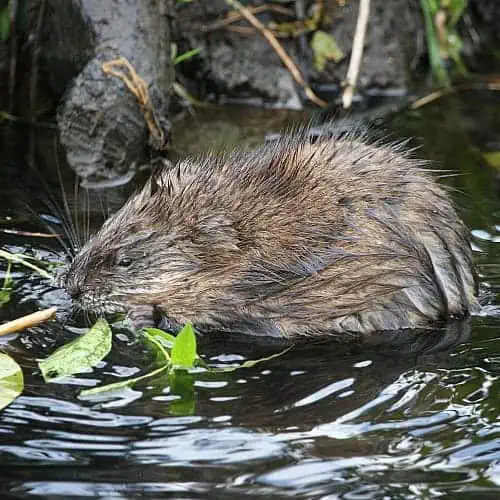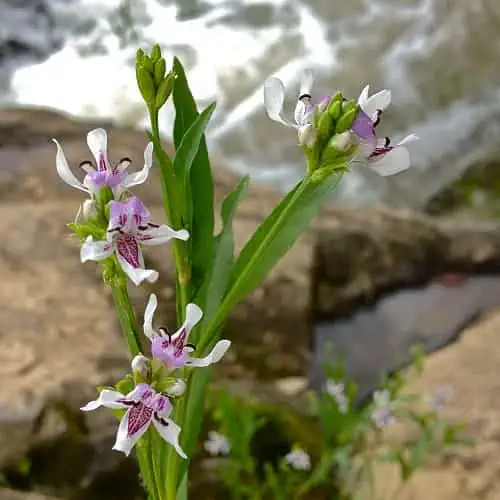
American water willow is a unique flowering plant in the Acanthaceae family. While most species in Acanthaceae are native to tropical locations, American water willow is especially cold hardy for the family and is native to North America. This plant’s common name comes from its leaves’ resemblance to willow leaves, although American water willow is not closely related to true willows. Its Latin genus name, Justicia, is an homage to 18th century Scottish botanist James Justice.
American water willow produces flowers which cluster at the tops of its stems. The flowers are often compared to that of orchids and are white with pale purple markings, with petals fusing into a tube-shape at the base (making it ideal for holding pollen and nectar for pollinators) and a single petal at the bottom sticking out like a sort of landing strip. These purple markings and the “landing strip” petal act as guides for bees who visit the flowers, as bees pick up colors on the blue portion of the UV spectrum more readily than most other colors.
Facts, Benefits & Uses of American Water Willow

American water willow is primarily pollinated by bees, although butterflies and other pollinators may visit this plant as well. This plant’s creeping rhizomes help it to form large colonies that populate the margins of ponds and other water sources. These same rhizomes provide important habitat for aquatic invertebrates and various fish species, which use the plant as shelter for spawning and safety from predators. In fact, many anglers target American water willow plants because they house so many fish. If you have a pond, your smaller fish will likely appreciate the shelter and habitat provided by American water willow!
Other species benefit from American water willow as well—amphibians, reptiles, and birds all eat the invertebrates that call the plant home. Deer may eat the leaves, while beavers, muskrats, and nutria eat the rhizomes. With water willow’s fast growth habit, this herbivory is unlikely to overly harm the plant and in fact may be a boon, helping to prevent it from overtaking areas while also providing a natural food source for a variety of wildlife.
*Note* If you notice a nutria, know that these are incredibly invasive and destructive animals in North America. You should report it immediately by visiting the Early Detection and Distribution Mapping System, selecting “Report Sightings” at the top, and adding in the applicable information. This can be used to report invasive plant species, as well. You should then contact your local wildlife office.
American Water Willow Growth, Hardiness & Climate

The growth rate of American water willow is moderate to rapid, with plants reaching a full height of one to three feet. More significant than their height, however, is their spread. American water willow spreads through rhizomes and can form large colonies of 1,000 square feet (90 square meters) or more. Because of the high potential for spreading, take care when deciding where to plant American water willow.
American water willow is hardy in zones 4-10, which is unusual for its family (Acanthaceae). As a perennial, it should survive the winter in these areas. Blooming typically occurs from May to September, although some blooms may stick around into October. American water willow’s unique flowers will be present for the longest amount of time if the plant is given access to full sunlight and plenty of moisture.
How to Plant American Water Willow In Ponds

A fairly easy plant, American water willow is commonly grown in ponds. Due to this plant’s propensity for spreading into large colonies, it is worth considering planting in a container such as a pot or planting bag. This will not totally limit spreading however, as this plant also propagates through seeds. American water willow will be happy on the margins and in the shallow water of a pond, or simply in very moist soil. The maximum depth under water is about ten inches for a mature plant.
How to Care For American Water Willow

American water willow prefers damp conditions and plentiful sunlight. Ideally, this species would be planted along the edge of your pond where you won’t have to worry about providing additional water. The most important element in caring for this plant is ensuring that its soil doesn’t dry out. Partial shade will likely result in a plant that has fewer blossoms, and may increase its spread as it’s more likely to devote more energy into rhizome production to expand into sunnier areas.
If you feel that your American water willow plant is spreading more than you would like, you can dig up some of the rhizomes and divide the plant. Absolutely do not plant this in natural waterways, particularly if you live outside of its native range. Be sure to clean any trimmed or dropped detritus from this plant to maintain healthy water quality in your pond. If you’re not replanting the rhizomes, don’t just toss them aside as they may re-establish there. Make sure to place them in the compost or the trash, or they even make a good gift for others (again, if they live in American water willow’s native range).
How to Winter American Water Willow
American water willow, unlike most other similar species in its family, is native to North America (including Canada), and as such is able to survive winters up to hardiness zone 4. There is no need for any special treatment to prepare American water willow for the winter in its native zones. American water willow is a perennial, so you should expect to see it in your pond for multiple years.
Is American Water Willow Toxic, Poisonous or Invasive?
American water willow is native to North America and is technically invasive outside of this range. It is not an extremely aggressive plant but will become widespread and form large colonies if allowed. Trimming it back every year or two should be enough to deter this.
As always, try to only use plants native to your specific region in your garden or pond. Regardless of where you live, it is a good idea to only plant American water willow in pots if you want to limit its spread through rhizomes. However, this plant does also spread through seeds. You can try trimming flower heads before they have a chance to go to seed, if you wish to limit spread. If your American water willow is growing/has grown out of control, or you find some outside of its native region, you can learn more about simple control options here.
American water willow is actually considered to be threatened in its northern range of Ontario, Canada. As the only member of the Acanthaceae family in the country, American water willow is protected in this area.
American water willow exhibits no known toxicity, and is therefore presumed safe for use in and around fish ponds.
Is American Water Willow Edible? Will Fish Eat it?
American water willow is likely edible to humans, and a variety of animals including deer, muskrats, and beavers eat it. Your fish will likely show interest in this plant for shelter and spawning habitat but are unlikely to try to eat it. If they do happen to nibble on the roots, your fish should not experience any negative effects.
Where to Buy American Water Willow & Seeds? (UK & US)
American water willow is easily obtained at plant nurseries throughout its native range. Elsewhere in the world, you will likely have to order it online if you are set on growing it in your own pond or garden. As always, please take care when selecting plants that are not native to your area.

